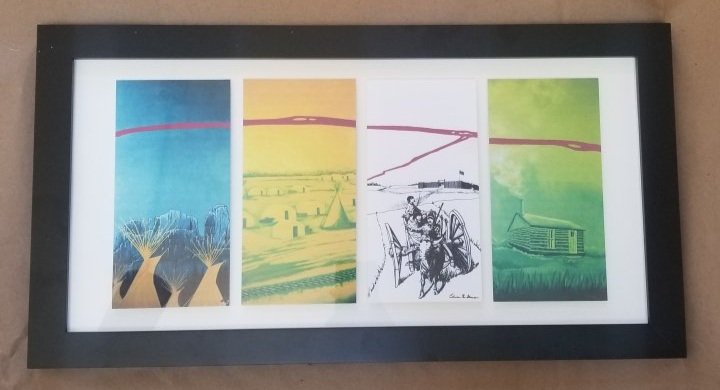CONVERGENCE
The confluence of the Elbow and Bow Rivers is a special place in Southern Alberta.
This art piece celebrates many special and little-known details of the Inglewood/Ramsay area, home to the Alexandra Centre Society.
These panels draw numerous elements together; we celebrate history, cultures, and community through their creation. The colours of the panels--red, blue, green, and white--have cultural significance and were inspired by the Metis sash.
The red ribbon floating across the panels was inspired by imagery from a 100-year-old map of the rivers and was overlaid onto the panels to represent the ties that connect and converge our cultures. It is also evocative of the chinook arch that all Calgarians can see from time to time on the Western horizon. Red also seemed to be the obvious choice as it connects us to Calgary’s branding, represents the blood of life, and is used as a celebratory colour in many cultures.
Content, cultures, history, community, and artists all come together to create… Convergence.
INDIVIDUAL PIECES:
ARTISTS & DESCRIPTIONS
Tipi’s: Winter Count
by Smith Wright
In the very beginning, The Siksika (Blackfoot) were a nomadic tribe, always following the buffalo.
They would hunt and gather throughout the plains during the warmer seasons. When winter came, the Siksika people would travel to the mountains using the forests as shelter from the cold winds and snowy plains.
Tent Town; Following the Railroad by Karen Scarlett
Once Fort Calgary was established, it attracted the railway where a tent town popped up along the tracks in what would become Inglewood.
The Alexandra Centre Society Building sits in the place where a tent town originally popped up along the railway tracks.
Red River Cart: Métis Arrive
by Edwin McGowan
A key reason for the Métis moving west was to provision the various forts scattered through what are now the Provinces of Saskatchewan and Alberta.
They also came to take up land to farm, hunt buffalo, and facilitate trade. The cart is an iconic symbol of the Metis. They were constructed in the Red River area of Manitoba for the journeys west, hence the term Red River Cart.
In the late 1800s and well into the 1900s the Inglewood area was predominantly populated by the Métis.
McVittie’s Cabin; Calgary’s First House by Karen Scarlett
McVittie’s Cabin was said to be the first house in Calgary
built by A.W.McVittie, a Dominion Land Surveyor
around 1882.
It was donated to the zoo by J.B.Cross and moved to the zoo on St. George's Island, in 1933.
It served many purposes over the years, Scout Hall, Tom Baines' office / first aid station. It was eventually moved to Heritage Park.
BUY CONVERGENCE ART MURALS
The Alexandra Centre Society has prints of the Convergence panel art available for order.
Prints will come framed and signed by the artists. They are available for $95 (set of 4 framed prints).
MEDIA COVERAGE
CTV News: New-inglewood-artwork-tells-of-the-areas-indigenous-history
City News: Inglewood-indigenous-mural-calgary
City News Article: Inglewood-indigenous-mural-calgary
City News on Twitter: New murals in Calgary's historic Inglewood are bringing its Indigenous past to the forefront
CJWE: Inglewood-art-shows-story-of-indigenous-history
The News Wire: Public Art Prints For Your Home
Kindersley Clarion: Calgary-public-art-public-art-available-as-prints-for-your-home
The Artists
EDWIN MCGOWAN
Edwin McGowan is Metis, born April 7, 1950, in Winnipeg. He is a retired Earth Scientist with an MSc. degree from the University of Manitoba and is currently enrolled at the Alberta University of the Arts in pursuit of a BFA degree.
Karen Scarlett
Karen Scarlett grew up fourth-generation on the family dairy farm west of Innisfail, Alberta. She has made art her entire life.
Karen lives in Calgary, Alberta where she works from her studio. You can find her work in public, corporate and private collections in Alberta and around the world.
Smith Wright
Smith Wright has made art his entire life. He is Siksika (Blackfoot). His work blends Siksika's traditional methods and practices with contemporary style and techniques. In 2021, Smith obtained his BFA degree in painting from the Alberta University of the Arts.
Funding: The Alexandra Centre Society would like to thank the City of Calgary and private donors that supported the Convergence art project.
In-Kind Donation: The ACS would also like to thank Calibre Construction for donating their time and labor to assist us with hanging the exterior art murals.
Special Support: The ACS would like to thank Troy Patenaude, Director of Cultural Development with Fort Calgary for his contributions to the project.

